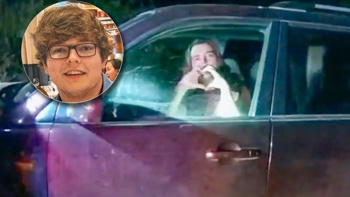The Government is being accused of breaking a campaign promise after announcing New Zealanders would face a 22c fuel tax hike and a $50 jump in vehicle registration fees.
Transport Minister Simeon Brown has kept National’s promise to axe Labour’s promised 12c fuel tax hike next term. Instead, he’s pushing the hike back until January 2027, in the next term of Parliament.
After the hike in January 2027, fuel taxes will increase by 6c a litre in 2028 and 4c a litre each following year. By the end of the next parliamentary term, the Government will have raised fuel taxes by 22c a litre.
These increases will be accompanied by an equivalent hike in road-user charges. Vehicle registrations will also jump by $50, a surprise change National had not campaigned on.
Despite claiming it was a “one-off fee”, in Brown’s announcement, he said: “To balance the transport budget, we are proposing an increase to the motor vehicle licensing fee by $25 in January 2025 and a further $25 in January 2026.”
Brown announced the increases as he released a draft version of the Government Policy Statement (GPS) on Land Transport, which is essentially a transport budget, setting out how much the Government wants to raise from road users in fuel taxes and road-user charges, and where it would like that money to be spent.
The draft will go out for consultation before taking effect on July 1 and take effect for the next six years, or until it is renewed, which will probably happen in three years.
Labour leader Chris Hipkins said the decision to hike taxes in the second term was effectively a broken campaign promise by simply hiking taxes in a hypothetical second term.
“They’ve introduced a big hike through effectively a new tax through the increase to driver registration or sorry vehicle registration and they are proposing now to increase fuel tax by more than the previous Government proposing to increase it,” Hipkins said.
Green Party transport spokeswoman Julie Anne Genter said the plan was “extreme”.
“It’s doubling down on the failed approach of last century and it will lead to more emissions, more congestion and higher transport costs for all of New Zealand,” she said.
The plan marks a big pivot back towards roading and away from the former Government’s enthusiasm for public transport and cycling.
The two centre pieces of the plan are a greater focus on road maintenance, with a pothole repair fund, and restarting the last National Government’s Roads of National Significance (Rons) programme, with 15 new roads set to be delivered under the programme.
Brown said the Rons were “some of New Zealand’s most successful state highway corridors, reducing congestion and improving safety”.
Genter said the plan would mean “more time stuck in traffic and more emissions. All we’re going to get from [this] approach is more congestion, carbon emissions and high transport costs”.
A cycling advocacy group, the Cycling Action Network, called the plans “a road to nowhere”.
Group spokesman Patrick Morgan said, “cutting investment in cycling, walking and public transport is unacceptable. [It will] cost lives, damage health, deepen the climate crisis and harm our communities”.
The draft GPS did not put a dollar figure on the new roads. Waka Kotahi NZ Transport Authority (NZTA) costings obtained by the Herald showed the roads could cost twice as much as National had budgeted for them during the election, leaving the party $24 billion short.
Brown said he had seen multiple pieces of advice on the cost of those roads. He would not say whether any of the cost estimates he had seen were within $2b of National’s own pre-election costings, which had a $2b contingency.
Prime Minister Christopher Luxon suggested he was unconcerned about the cost overruns, saying building a modern transport system was crucial, and hinted the shortfall in funding could be made up by using tools like public-private partnerships.
“We cannot keep doing things the way we’ve been doing it,” Luxon said, when saying he made no apologies for using “innovative” funding tools to improve infrastructure.
Brown said NZTA would assess the projects and go to the market to look for private sector investment.
The GPS tells NZTA how much money should be spent in different areas of the transport system, called “activity classes”.
Brown has created two new activity classes for pothole prevention. One class will spend up to $2.3b on pothole maintenance for Government-owned state highways, the other class will spend up to $2.5b on fixing potholes on council-owned local roads.
Brown said he wanted the funding to lead to “2 per cent of the state highway network renewed each year”.
/cloudfront-ap-southeast-2.images.arcpublishing.com/nzme/DUK2XR4YUJC5ZESZJM645PV6R4.jpg)
Transport Minister Simeon Brown set out the Government's transport funding priorities. Photo / Mark Mitchell
The plan has seen some big cuts from when Labour was in charge. Labour also published a draft GPS for the same period. National has killed funding for inter-regional rail, which could mean an end to the Te Huia train line.
It has also axed funding for coastal shipping, which had been given up to $20 million a year. This funding was to encourage people to ship freight by water, rather than putting it on trucks. Labour reasoned this would take pressure off the roading network by having fewer trucks.
Funding for public transport has been cut dramatically. Labour planned to spend up to $3.2b on public transport infrastructure over the next three years. This has been slashed by nearly $1b.
The funding pot for council subsidies to public transport services has also been cut, which could result in councils having to hike fares. Labour had promised up to $2.8b in subsidies over the next three years. The new Government has cut this to $2.3b.
Brown said the last Government increased public transport funding by 71 per cent in five years, despite patronage declining by 23 per cent - although he conceded some of this was due to the Covid-19 pandemic.
He said the “private share” of funding for public transport had fallen from 32 per cent to 11 per cent over the same time.
Funding for walking and cycling improvements has nearly been halved, from $1b under Labour to $510m under this plan.
Brown indicated further work will be done to fix the broken transport revenue system, under which revenue raised from fuel taxes has dwindled.
This work was begun under the last National Government and was significantly accelerated under the last Labour Government. The changes will probably mean an end to fuel taxes, which would be replaced by a universal road-user charge.
/cloudfront-ap-southeast-2.images.arcpublishing.com/nzme/5DA7JKDRRRDNLBV2N57LG4D52E.jpg)
The Government has unveiled its transport funding priorities, including 15 "roads of national significance". Photo / Michael Craig
Adam Pearse is a political reporter in the NZ Herald Press Gallery team, based at Parliament. He has worked for NZME since 2018, covering sport and health for the Northern Advocate in Whangārei before moving to the Herald in Auckland, covering Covid-19 and crime.
Take your Radio, Podcasts and Music with you









